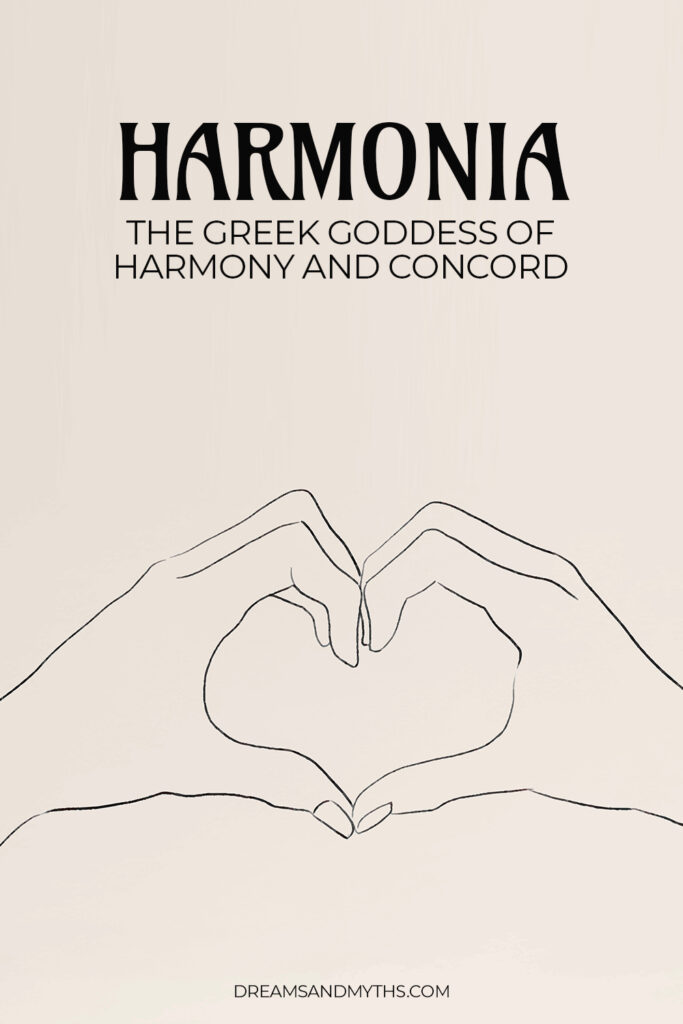In Greek Mythology, Harmonia was an immortal goddess of harmony and concord who presided over marital harmony, soothing strife, and harmonious actions between soldiers in war.
Although not considered one of the Greek pantheon’s significant goddesses, Harmonia still played a fundamental part in Greek Mythology.
According to Roberto Calasso’s bestselling novel, ‘’The Marriage of Cadmus and Harmony’’, the wedding of Harmonia with Cadmus marked the last time mortals and gods met on earth with friendly terms. Their marriage is regarded as the end of the golden age of mythology.

If Harmonia was the characteristic of peace, she also had a natural opposite, ‘Eris’, the goddess of disharmony and strife.
It seems that the ancient Greeks were well aware that two strong emotions, such as harmony and strife, need to complement each other in the universe. These two goddesses also have their Roman equivalent, where Harmony is Concordia and Eris is Discordia.
Greek Mythology traces the tales of gods and goddesses, several other mortals, and immortal characters who teach about leading life and the importance of accepting both good and evil.
In this article, we will explore the life of goddess Harmonia, her birth as a result of an adulterous affair between Ares and Aphrodite, and her association with the cursed necklace.
The Birth of Harmonia
Harmonia was the daughter of Aphrodite, the Greek goddess of fertility, sexual love, and beauty, and Ares, the Greek god of war and courage.
Aphrodite was married to Hephaestus, the Greek god of fire, blacksmiths, and metalworking. However, Aphrodite despised her husband’s lame appearance and remained unfaithful to him, and her extramarital affair with Ares resulted in the birth of Harmonia.
Aphrodite and Ares also have other children, which include Eros, Phobos, Deimos, Adrestia, and Phlegyas.
Hephaestus eventually got wind of his wife’s infidelity with Ares and caught the pair in a magical net. All the other gods and goddesses witnessed the extramarital affair.
Nevertheless, that did not deter Aphrodite from taking in Ares as her lover, and their relationship did bring forth Harmonia.
In another version of the story, Harmonia was the daughter of Zeus with one of his consorts, Electra, born on the island of Samothrace. This other narrative of Harmonia’s birth originates from the Theban account and is not popularly known.
One common trait between both stories is that Aphrodite is mentioned in both versions. Harmonia is Aphrodite’s daughter in Greek Mythology and is also a close ally of Aphrodite in the Theban account.
Harmonia was the characteristic of peace, and later some Greek and Roman writers portrayed her as harmony in an abstract sense – a deity who represents cosmic harmony.
Moreover, Harmonia’s counterpart in Greek Mythology, Eris, the goddess of discord, was the sister of Ares, which means Harmonia was the niece of her natural opposite in the Greek pantheon.
The existence of Harmonia and Eris reminds us of a quote by the famous Greek philosopher ‘Pythagoras’ who once said, ‘’If there is light, then there is darkness’’. It shows that Greek Mythology is deeply rooted in balancing the law of the universe. There is a polar opposite for everything.
Thus, if Eris was already born as the symbol of the goddess of discord, then the birth of Harmonia was inevitable in the pantheon.
The Sacred Union of Harmonia And Cadmus

In every version of Harmonia’s story, she is the wife of the mortal Greek hero Cadmus.
Cadmus was the son of Phoenix or Agenor (King of Phoenicia) and the brother of Europa, who was carried away by Zeus, the king of gods and thunder, and became his consort.
When Cadmus was unsuccessful in finding his sister, he consulted the oracle of Delphi, who told him to follow a cow and build a town where the cow lays down.
Cadmus followed the cow to Boeotia (Cow Land), where he laid the foundation for a new city called Cadmeia, which would later become Thebes.
The Greek hero Cadmus has had many adventures in his life and his fate tangled with Harmonia when he pleased Goddess Athena with a sacrifice. Cadmus killed a serpent dragon in Ismenian spring. In short, he wanted to get water to sanctify his sacrifice to the goddess Athena.
It was Athena, the daughter of Zeus and the goddess of war and wisdom, who asked Cadmus to sow the serpent dragon teeth after the cow laid down in Boeotia. A race of fierce armed men, known as ‘Spartoi’, sprang from the sown serpent dragon teeth.
These men helped Cadmus build the citadel of Thebes and became the founders of the noblest families in that city.
Unfortunately, as fate would have it, the serpent dragon was sacred to Ares, and Cadmus was instructed to do penance for eight years, serving Ares as punishment.
Impressed by his dedication, Athena requested the gods that Cadmus was worthy of an immortal bride. The gods betrothed Harmonia to Cadmus, whose name means ‘good composition’ as a wife.
Hence, an immortal goddess and a mortal hero became companions for life who would accompany each to eternity.
The Marriage of Harmonia
The gods blessed goddess Harmonia as a bride to the Greek hero Cadmus. She became the first and only wife of Cadmus and queen of Thebes.
Their marriage ceremony was a grand affair attended by all the gods and goddesses and the heroes of Greek mythology.
The Muses, who are the inspirational goddesses of science, literature, and arts, sang at the banquet, and gods and mortals presented lavish gifts to the couple.
Here the goddess of marriage presented an elegant throne. And Hermes, the patron god of shepherds, gifted a scepter. On the other hand, Ares, the bride’s father, gave her a spear.
However, the most intriguing gift was a robe and necklace presented by Cadmus himself for his bride. The necklace caused the fall of kingdoms and brought forth a string of misfortunes for Harmonia and her family.
The Cursed Necklace

Hephaestus was gloomy and angry by the betrayal of his wife Aphrodite with her lover Ares. It was said that the necklace gifted by Cadmus to his wife, Harmonia, was the work of Hephaestus.
Overcome by grief and pain, Hephaestus vowed to avenge himself by cursing the lineage of children resulting from the affair. And the cursed necklace reached Harmonia.
Upon hearing about the royal engagement, Hephaestus crafted the cursed necklace, which doomed the descendants of Harmonia and Cadmus to endless tragedy.
Even the most beautiful roses have thorns. The stunning jewelry was thus cursed with thorns to bring catastrophe for the newly wedded couple.
The necklace was usually described in the shape of two serpents whose open mouths formed a clasp adorned by valuable stones. Whether it’s coincidence or destiny, even Harmonia and Cadmus metamorphosed into two serpents in the end.
The piece of jewelry is mentioned in several Greek Tales and was said to have magical properties. The necklace, known colloquially as the necklace of Goddess Harmonia, allowed any woman wearing it to remain young and beautiful eternally.
Therefore, the necklace was a coveted object in the house of Thebes. Enamored by this beautiful jewelry, nobody cared about the disaster it brought.
In a few versions of the story, the necklace was directly gifted by Hephaestus to Harmonia, whereas in other versions, it was a present from Cadmus. In the end, the cursed necklace landed with Harmonia in every version of the tale.
According to Latin Author Gaius Julius Hyginus, it was not the necklace but the robe dipped in crime that brought misfortunes upon Harmonia. He says that Hera and Hephaestus gifted the robe and necklace. The necklace trapped Harmonia’s powers, and the robe brought upon a fate of adversity.
There are still several Greek legends about the cursed necklace of Harmonia, yet there is little detail about what happens to the jewelry in the end.
Bonus Read: The 11 famous tales from Greek mythology that explore various symbols of life.
The Marital Life of Goddess Harmonia
Harmonia became the queen of Thebes after her marriage to Cadmus. She gave birth to a son named Polydorus and four daughters, Ino, Autonoe, Agave, and Semele, and another youngest son Illyrius who was born much later.
The couple did not bask in the marital bliss for long as the family was plagued by misfortunes soon. Despite the divinely ordained nature of his kingdom and the marriage, Cadmus had to regret both. His family was caught in catastrophes, and his kingdom Thebes was gripped by civil unrest.
Harmonia’s daughter Semele was destroyed by Hera, the wife of Zeus, because of her close relationship with the chief Greek deity. Not to forget, Semele had a son, Dionysus, the Greek god of wine and ecstasy, with Zeus.
Hera, known to protect women during childbirth, indirectly killed Harmonia’s other daughter, ‘Ino’, by making her jump into the sea with her only surviving son.
Hounds killed Autonoe’s son Actaeon, and Dionysus cursed both Autonoe and her sister Agave to madness when Agave’s son Pentheus refused to worship Dionysus.
Dionysus also had Pentheus’s limb ripped by Agave and Autonoe in a feat of madness.
The couple’s daughter had a tragic life, and their fifth child, Polydorus, would go on to become the King of Thebes after his parent’s exile from Thebes. It seems the gods had no mercy towards the descendants of Harmonia, and even Polydorus died young from natural causes after coronating his young son Labdacus as the ruler of Thebes.
Harmonia left with her husband to Illyria after the tragedy in Thebes and gave birth to their youngest child, Illyrius, who was set to become the ruler of Illyria.
The End: Harmonia And Cadmus Live For Eternity
After several disasters, Harmonia accompanies her husband, Cadmus, to Northern Greece, where Encheleans tribes lived.
The Encheleans conflicted with their neighbors, and Cadmus would aid them in their conflict by uniting the warring tribes and naming the new kingdom Illyria. Harmonia and Cadmus became the rulers of the new kingdom, and their youngest son, Illyrius, would become the future king of Illyria.
One day, distressed by his misfortunes, Cadmus remarked that if serpents are so beloved to the gods, he might as well become a serpent. Ares granted his wish, and Cadmus immediately began growing scales on his body, transforming into a serpent.
Upon witnessing the serpent form of Cadmus, Harmonia begged the gods to share her husband’s fate, and her wish was granted, turning Harmonia into a beautiful serpent.
The couple began residing in the Elysian plains as serpents and lived together for eternity. In ancient Greek mythology, the Elysian plains or fields are the final resting place or paradise for the souls of valiant heroes and virtuous mortals.
Thus ends the tale of Harmonia, who lived for eternity with her husband and remained the symbol of cosmic harmony in the Greek pantheon of Gods.
Verdict
Harmonia’s story is a gripping tale of our own life. It shows how not even a goddess blessed by divine powers can escape the mirage of life.
Nobody is blessed with happiness until eternity. From the moment we are born, our life is a mixture of good and bad moments where we are bound to experience grief and loss, despite having all the riches in the world.
The tragedies are what make life meaningful. Harmonia and Cadmus were cursed to lead a life of misfortunes. If we think deeply, it feels unfair that this couple had to go through several calamities without any fault of their own.
Sadly, that’s life, and Greek mythology defines the course of life in a very subtle sense.
Unlike several Greek heroes and gods, Cadmus never left his wife or married any consorts despite everything, and their love story lived until eternity.
It shows how with the support of the right people and our own determination, we are capable of withstanding every misadventure.
In the end, we are left with praise for Harmonia’s courage to withstand every mishap with her husband and for Cadmus being a valiant Greek hero.
